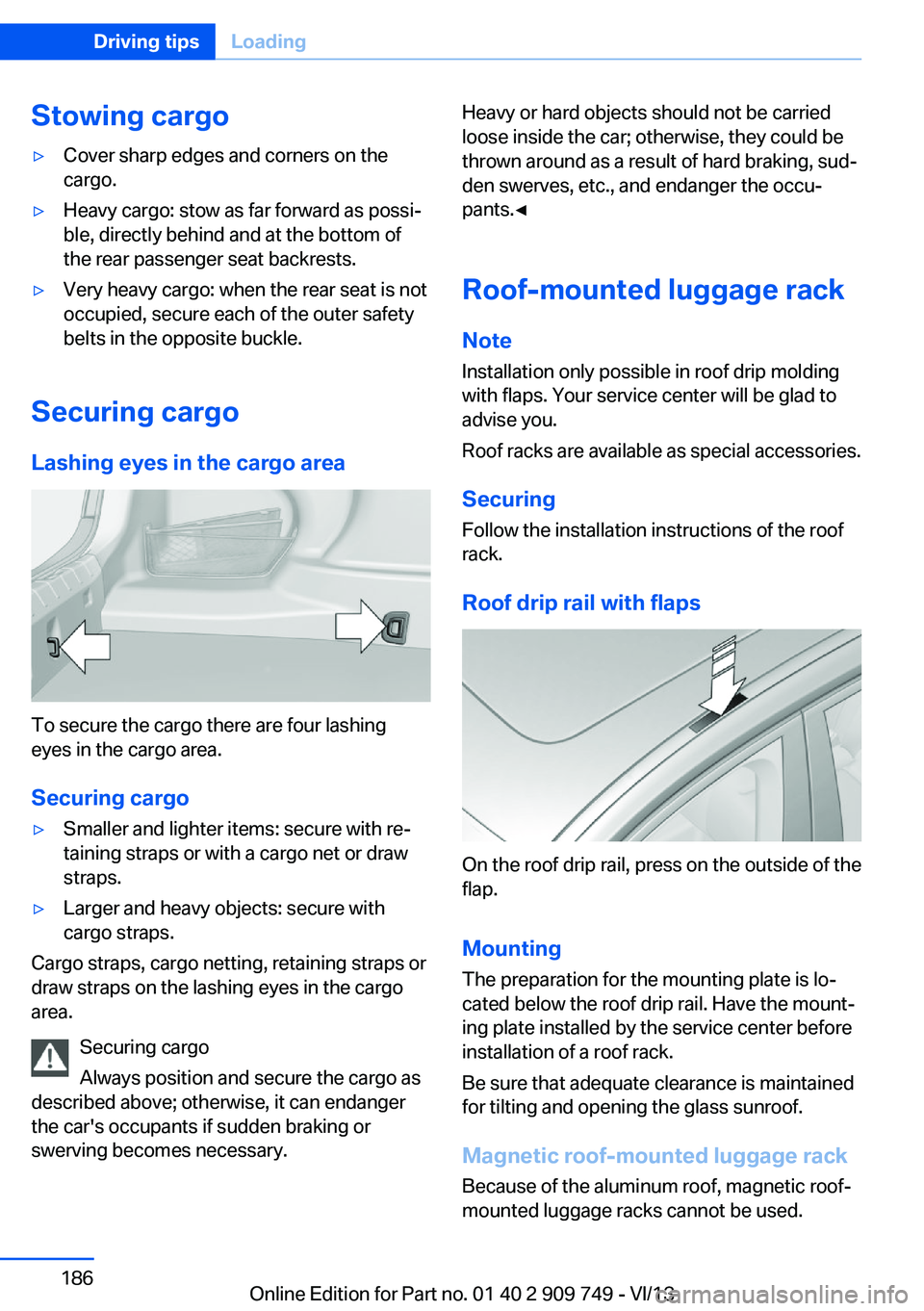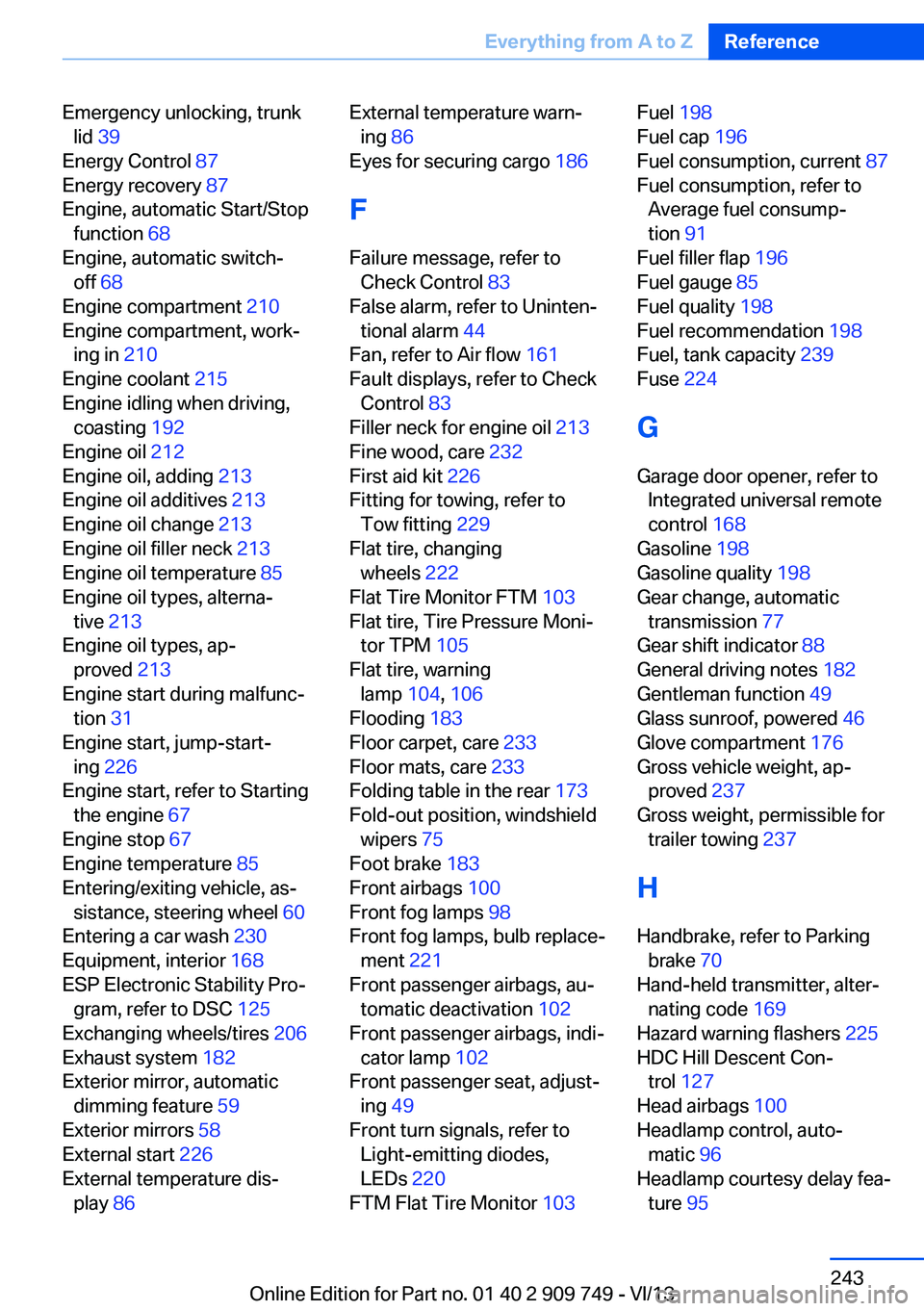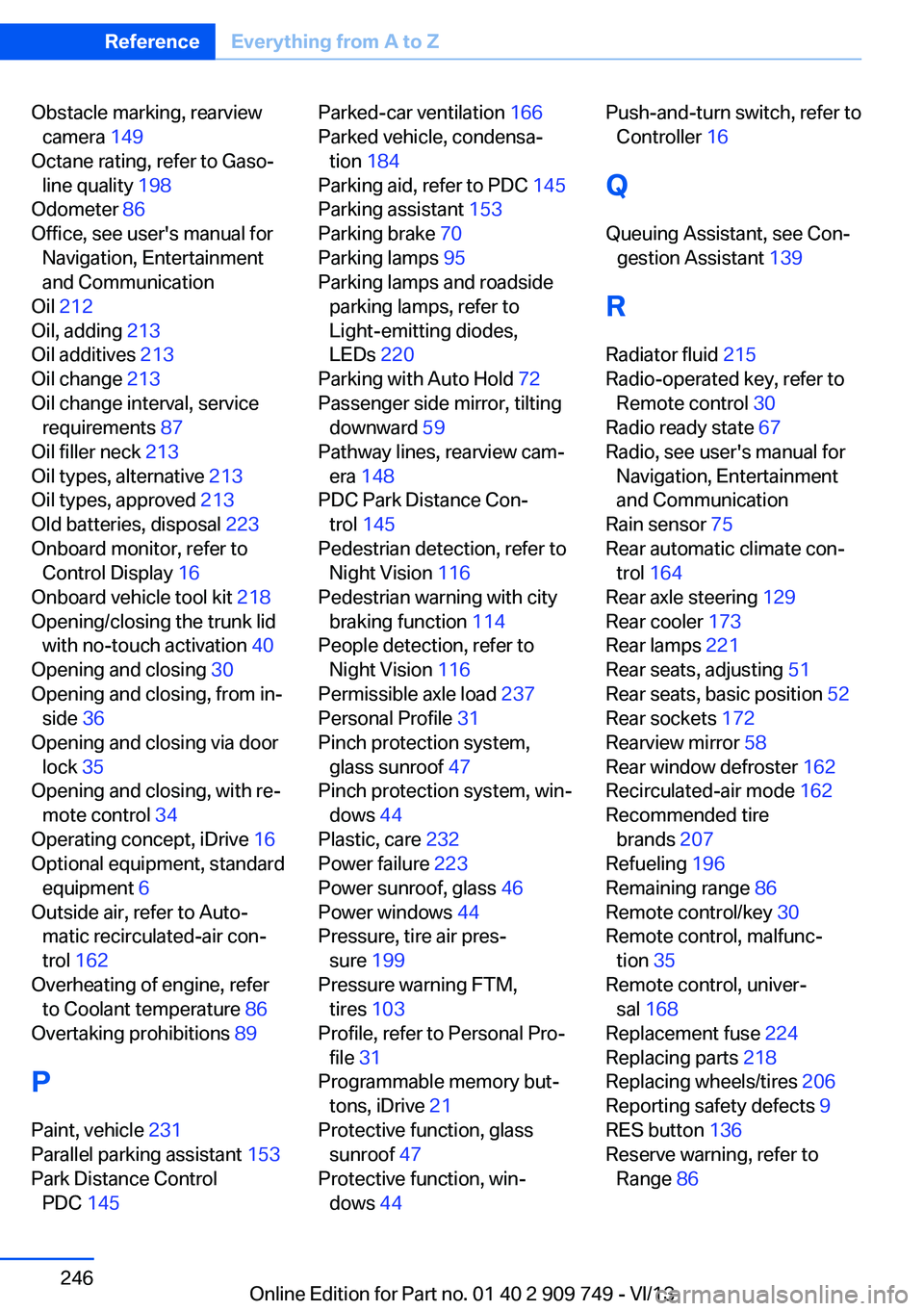2014 BMW 750LI XDRIVE sunroof
[x] Cancel search: sunroofPage 186 of 251

Stowing cargo▷Cover sharp edges and corners on the
cargo.▷Heavy cargo: stow as far forward as possi‐
ble, directly behind and at the bottom of
the rear passenger seat backrests.▷Very heavy cargo: when the rear seat is not
occupied, secure each of the outer safety
belts in the opposite buckle.
Securing cargo
Lashing eyes in the cargo area
To secure the cargo there are four lashing
eyes in the cargo area.
Securing cargo
▷Smaller and lighter items: secure with re‐
taining straps or with a cargo net or draw
straps.▷Larger and heavy objects: secure with
cargo straps.
Cargo straps, cargo netting, retaining straps or
draw straps on the lashing eyes in the cargo
area.
Securing cargo
Always position and secure the cargo as
described above; otherwise, it can endanger
the car's occupants if sudden braking or
swerving becomes necessary.
Heavy or hard objects should not be carried
loose inside the car; otherwise, they could be
thrown around as a result of hard braking, sud‐
den swerves, etc., and endanger the occu‐
pants.◀
Roof-mounted luggage rack
Note Installation only possible in roof drip moldingwith flaps. Your service center will be glad to
advise you.
Roof racks are available as special accessories.
Securing
Follow the installation instructions of the roof
rack.
Roof drip rail with flaps
On the roof drip rail, press on the outside of the
flap.
Mounting
The preparation for the mounting plate is lo‐
cated below the roof drip rail. Have the mount‐
ing plate installed by the service center before
installation of a roof rack.
Be sure that adequate clearance is maintained
for tilting and opening the glass sunroof.
Magnetic roof-mounted luggage rack Because of the aluminum roof, magnetic roof-
mounted luggage racks cannot be used.
Seite 186Driving tipsLoading186
Online Edition for Part no. 01 40 2 909 749 - VI/13
Page 188 of 251

Saving fuelVehicle equipmentAll standard, country-specific and optional
equipment that is offered in the model series is
described in this chapter. Therefore, equip‐
ment is also described that is not available in a
vehicle, e. g., because of the selected optional
equipment or country variant. This also applies
for safety-related functions and systems.
General information Your vehicle contains advanced technology for
the reduction of fuel consumption and emis‐
sions.
Fuel consumption depends on a number of dif‐
ferent factors.
The implementation of certain measures, driv‐
ing style and regular maintenance can have an
influence on fuel consumption and on the envi‐
ronmental impact.
Remove unnecessary cargoAdditional weight increases fuel consumption.
Remove attached parts
following use
Remove auxiliary mirrors, roof or rear luggage
racks which are no longer required following
use.
Attached parts on the vehicle impair the aero‐
dynamics and increase the fuel consumption.Close the windows and glass
sunroof
Driving with the glass sunroof and windows
open results in increased air resistance and
raises fuel consumption.
Tires General information
Tires can affect fuel consumption values in
various ways, for instance fuel consumption
can be influenced by the size of the tires.
Check the tire inflation pressure
regularly
Check and, if necessary, correct the tire infla‐
tion pressure at least twice a month and before
starting on a long trip.
Low tire inflation pressure increases rolling re‐
sistance and thus raises fuel consumption and
tire wear.
Drive away without delay Do not wait for the engine to warm-up while
the vehicle remains stationary. Start driving
right away, but at moderate engine speeds.
This is the fastest way for the cold engine to
reach its operating temperature.
Look well ahead when
driving
Avoid unnecessary acceleration and braking.
By maintaining a suitable distance to the vehi‐
cle driving ahead of you.
Driving smoothly and looking ahead reduces
fuel consumption.Seite 188Driving tipsSaving fuel188
Online Edition for Part no. 01 40 2 909 749 - VI/13
Page 230 of 251

CareVehicle equipmentAll standard, country-specific and optional
equipment that is offered in the model series is
described in this chapter. Therefore, equip‐
ment is also described that is not available in a
vehicle, e. g., because of the selected optional
equipment or country variant. This also applies
for safety-related functions and systems.
Car washes Hints Steam jets or high-pressure washers
When using steam jets or high-pressure
washers, hold them a sufficient distance away and use a maximum temperature of
140 ℉/60 ℃.
If the vehicle has a glass sunroof, ensure that a distance of at least 31.5 inches/80 cm is main‐
tained. Holding them too close or using exces‐
sively high pressures or temperatures can
cause damage or preliminary damage that may
then lead to long-term damage.
Follow the user's manual for the high-pressure
washer.◀
Cleaning sensors/cameras with high-
pressure washers
When using high-pressure washers, do not
spray the exterior sensors and cameras, e.g., Park Distance Control, for extended periods of
time and only from a distance of at least
12 in/30 cm.◀
Regularly remove foreign items such as leaves
in the area below the windshield when the
hood is raised.
Wash your vehicle frequently, particularly in
winter.Intense soiling and road salt can damage the
vehicle.
Automatic car washes
Hints
Note the following:▷Give preference to cloth car washes or
those that use soft brushes in order to
avoid paint damage.▷Make sure that the wheels and tires are not
damaged by the transport mechanisms.▷Fold in the exterior mirrors; otherwise, they
may be damaged, depending on the width
of the vehicle.▷Deactivate the rain sensor, refer to
page 75, to avoid unintentional wiper acti‐
vation.▷In some cases, an unintentional alarm can
be triggered by the interior motion sensor
of the alarm system. Follow the instruc‐
tions on avoiding an unintentional alarm,
refer to page 44.
Guide rails in car washes
Avoid car washes with guide rails higher
than 4 in/10 cm; otherwise, the vehicle body
could be damaged.◀
Before driving into a car wash In order to ensure that the vehicle can roll in a
car wash, take the following steps:
1.Drive into the car wash.2.Engage transmission position N.3.Switch the engine off.
In this way, the ignition remains switched
on, and a Check-Control message is dis‐
played.Seite 230MobilityCare230
Online Edition for Part no. 01 40 2 909 749 - VI/13
Page 243 of 251

Emergency unlocking, trunklid 39
Energy Control 87
Energy recovery 87
Engine, automatic Start/Stop function 68
Engine, automatic switch- off 68
Engine compartment 210
Engine compartment, work‐ ing in 210
Engine coolant 215
Engine idling when driving, coasting 192
Engine oil 212
Engine oil, adding 213
Engine oil additives 213
Engine oil change 213
Engine oil filler neck 213
Engine oil temperature 85
Engine oil types, alterna‐ tive 213
Engine oil types, ap‐ proved 213
Engine start during malfunc‐ tion 31
Engine start, jump-start‐ ing 226
Engine start, refer to Starting the engine 67
Engine stop 67
Engine temperature 85
Entering/exiting vehicle, as‐ sistance, steering wheel 60
Entering a car wash 230
Equipment, interior 168
ESP Electronic Stability Pro‐ gram, refer to DSC 125
Exchanging wheels/tires 206
Exhaust system 182
Exterior mirror, automatic dimming feature 59
Exterior mirrors 58
External start 226
External temperature dis‐ play 86 External temperature warn‐
ing 86
Eyes for securing cargo 186
F
Failure message, refer to Check Control 83
False alarm, refer to Uninten‐ tional alarm 44
Fan, refer to Air flow 161
Fault displays, refer to Check Control 83
Filler neck for engine oil 213
Fine wood, care 232
First aid kit 226
Fitting for towing, refer to Tow fitting 229
Flat tire, changing wheels 222
Flat Tire Monitor FTM 103
Flat tire, Tire Pressure Moni‐ tor TPM 105
Flat tire, warning lamp 104, 106
Flooding 183
Floor carpet, care 233
Floor mats, care 233
Folding table in the rear 173
Fold-out position, windshield wipers 75
Foot brake 183
Front airbags 100
Front fog lamps 98
Front fog lamps, bulb replace‐ ment 221
Front passenger airbags, au‐ tomatic deactivation 102
Front passenger airbags, indi‐ cator lamp 102
Front passenger seat, adjust‐ ing 49
Front turn signals, refer to Light-emitting diodes,
LEDs 220
FTM Flat Tire Monitor 103 Fuel 198
Fuel cap 196
Fuel consumption, current 87
Fuel consumption, refer to Average fuel consump‐
tion 91
Fuel filler flap 196
Fuel gauge 85
Fuel quality 198
Fuel recommendation 198
Fuel, tank capacity 239
Fuse 224
G
Garage door opener, refer to Integrated universal remote
control 168
Gasoline 198
Gasoline quality 198
Gear change, automatic transmission 77
Gear shift indicator 88
General driving notes 182
Gentleman function 49
Glass sunroof, powered 46
Glove compartment 176
Gross vehicle weight, ap‐ proved 237
Gross weight, permissible for trailer towing 237
H
Handbrake, refer to Parking brake 70
Hand-held transmitter, alter‐ nating code 169
Hazard warning flashers 225
HDC Hill Descent Con‐ trol 127
Head airbags 100
Headlamp control, auto‐ matic 96
Headlamp courtesy delay fea‐ ture 95 Seite 243Everything from A to ZReference243
Online Edition for Part no. 01 40 2 909 749 - VI/13
Page 246 of 251

Obstacle marking, rearviewcamera 149
Octane rating, refer to Gaso‐ line quality 198
Odometer 86
Office, see user's manual for Navigation, Entertainment
and Communication
Oil 212
Oil, adding 213
Oil additives 213
Oil change 213
Oil change interval, service requirements 87
Oil filler neck 213
Oil types, alternative 213
Oil types, approved 213
Old batteries, disposal 223
Onboard monitor, refer to Control Display 16
Onboard vehicle tool kit 218
Opening/closing the trunk lid with no-touch activation 40
Opening and closing 30
Opening and closing, from in‐ side 36
Opening and closing via door lock 35
Opening and closing, with re‐ mote control 34
Operating concept, iDrive 16
Optional equipment, standard equipment 6
Outside air, refer to Auto‐ matic recirculated-air con‐
trol 162
Overheating of engine, refer to Coolant temperature 86
Overtaking prohibitions 89
P Paint, vehicle 231
Parallel parking assistant 153
Park Distance Control PDC 145 Parked-car ventilation 166
Parked vehicle, condensa‐ tion 184
Parking aid, refer to PDC 145
Parking assistant 153
Parking brake 70
Parking lamps 95
Parking lamps and roadside parking lamps, refer to
Light-emitting diodes,
LEDs 220
Parking with Auto Hold 72
Passenger side mirror, tilting downward 59
Pathway lines, rearview cam‐ era 148
PDC Park Distance Con‐ trol 145
Pedestrian detection, refer to Night Vision 116
Pedestrian warning with city braking function 114
People detection, refer to Night Vision 116
Permissible axle load 237
Personal Profile 31
Pinch protection system, glass sunroof 47
Pinch protection system, win‐ dows 44
Plastic, care 232
Power failure 223
Power sunroof, glass 46
Power windows 44
Pressure, tire air pres‐ sure 199
Pressure warning FTM, tires 103
Profile, refer to Personal Pro‐ file 31
Programmable memory but‐ tons, iDrive 21
Protective function, glass sunroof 47
Protective function, win‐ dows 44 Push-and-turn switch, refer to
Controller 16
Q Queuing Assistant, see Con‐ gestion Assistant 139
R
Radiator fluid 215
Radio-operated key, refer to Remote control 30
Radio ready state 67
Radio, see user's manual for Navigation, Entertainment
and Communication
Rain sensor 75
Rear automatic climate con‐ trol 164
Rear axle steering 129
Rear cooler 173
Rear lamps 221
Rear seats, adjusting 51
Rear seats, basic position 52
Rear sockets 172
Rearview mirror 58
Rear window defroster 162
Recirculated-air mode 162
Recommended tire brands 207
Refueling 196
Remaining range 86
Remote control/key 30
Remote control, malfunc‐ tion 35
Remote control, univer‐ sal 168
Replacement fuse 224
Replacing parts 218
Replacing wheels/tires 206
Reporting safety defects 9
RES button 136
Reserve warning, refer to Range 86 Seite 246ReferenceEverything from A to Z246
Online Edition for Part no. 01 40 2 909 749 - VI/13